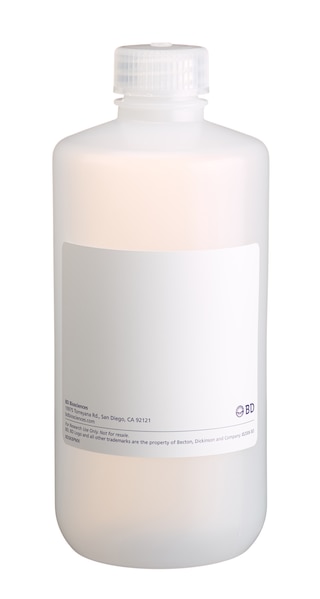Old Browser
This page has been recently translated and is available in French now.
Looks like you're visiting us from {countryName}.
Would you like to stay on the current country site or be switched to your country?




Analysis of Btk in human peripheral blood lymphocytes. Human whole blood was lysed and fixed with 1X BD Phosflow™ Lyse/Fix Buffer (Cat. No. 558049) for 10-15 minutes at 37ºC, then permeabilized (BD Phosflow™ Perm Buffer II, Cat. No. 558052) on ice for 30 minutes, and then stained with either Alexa Fluor® 647 Mouse anti-Btk (Cat. No. 558528, solid-line histogram) or Alexa Fluor® 647 Mouse IgG2a isotype control mAb MOPC-173 (Cat. No. 558053, dashed-line histogram). Flow cytometry was performed on a BD FACSCalibur™ flow cytometry system. The figure displays lymphocytes that were selected by their scatter profile, and the cells showing higher Btk expression are B lymphocytes.


BD™ Phosflow Alexa Fluor® 647 Mouse anti-Btk

Regulatory Status Legend
Any use of products other than the permitted use without the express written authorization of Becton, Dickinson and Company is strictly prohibited.
Preparation And Storage
Product Notices
- This reagent has been pre-diluted for use at the recommended Volume per Test. We typically use 1 × 10^6 cells in a 100-µl experimental sample (a test).
- An isotype control should be used at the same concentration as the antibody of interest.
- Source of all serum proteins is from USDA inspected abattoirs located in the United States.
- Caution: Sodium azide yields highly toxic hydrazoic acid under acidic conditions. Dilute azide compounds in running water before discarding to avoid accumulation of potentially explosive deposits in plumbing.
- The Alexa Fluor®, Pacific Blue™, and Cascade Blue® dye antibody conjugates in this product are sold under license from Molecular Probes, Inc. for research use only, excluding use in combination with microarrays, or as analyte specific reagents. The Alexa Fluor® dyes (except for Alexa Fluor® 430), Pacific Blue™ dye, and Cascade Blue® dye are covered by pending and issued patents.
- Alexa Fluor® 647 fluorochrome emission is collected at the same instrument settings as for allophycocyanin (APC).
- For fluorochrome spectra and suitable instrument settings, please refer to our Multicolor Flow Cytometry web page at www.bdbiosciences.com/colors.
- Alexa Fluor® is a registered trademark of Molecular Probes, Inc., Eugene, OR.
- Please refer to www.bdbiosciences.com/us/s/resources for technical protocols.
Companion Products


Bruton's tyrosine kinase (Btk) is a nonreceptor tyrosine kinase whose function is critical for proper B cell development and signaling. It is a member of the Tec family of kinases which includes Tec and Itk. This family is similar to the src family of tyrosine kinases. However, Tec family members lack the N-terminal myristylation site and the regulatory C-terminal tyrosine that are found in src proteins. In addition to an N-terminal pleckstrin homology (PH) domain, the Tec proteins contain Src homology domains 2 and 3 (SH2 and SH3) and a stretch of 60-80 amino acids between the PH and SH3 domains termed the Tec homology domain. The activity of Btk is regulated by Src-mediated phosphorylation of the kinase domain at tyrosine 551. This event induces Btk kinase activity and subsequent autophosphorylation at tyrosine 223 in the SH3 domain. Phosphorylated Btk then associates with the cell membrane via the interaction of the PH domain with phosphatidylinositol 3, 4, 5-triphosphate. The PH domain is essential for proper activation and function of Btk. A mutation in the PH domain results in Xid, murine X-linked immunodeficiency, and human X-linked agammaglobulinemia.
Development References (3)
-
Mahajan S, Fargnoli J, Burkhardt AL, Kut SA, Saouaf SJ, Bolen JB. Src family protein tyrosine kinases induce autoactivation of Bruton's tyrosine kinase. Mol Cell Biol. 1995; 15:5304-5311. (Biology). View Reference
-
Marshall AJ, Niito H, Yun TJ, Clark EA. Regulation of B-cell activation and differentiation by the phosphatidylinositol 3-kinase and phospholipase Cγ pathway. Immunol Rev. 2000; 176:30-46. (Biology). View Reference
-
Rawlings DJ, Scharenberg AM, Park H, et al. Activation of BTK by a phosphorylation mechanism initiated by SRC family kinases. Science. 1996; 271:822-825. (Biology). View Reference
Please refer to Support Documents for Quality Certificates
Global - Refer to manufacturer's instructions for use and related User Manuals and Technical data sheets before using this products as described
Comparisons, where applicable, are made against older BD Technology, manual methods or are general performance claims. Comparisons are not made against non-BD technologies, unless otherwise noted.
For Research Use Only. Not for use in diagnostic or therapeutic procedures.
Report a Site Issue
This form is intended to help us improve our website experience. For other support, please visit our Contact Us page.